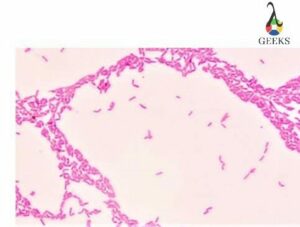In this post you will find the examples of Vibrio bacteria, their shape and facts around it
Vibrios are group of gram-negative bacteria having short comma-shaped body with printed ends. They are mostly aquatic in nature and some species of Vibrio causes severe ailment in humans.
Vibrio Bacteria Examples
- Vibrio cholerae
- Vibrio alginolyticus
- Vibrio damsela
- Vibrio fluvialis
- Vibrio furnissii
- Vibrio fischeri
- Vibrio vulnificus
Shape
Microscopically, they are slightly curved rod-shaped bacteria. Highly motile having single polar flagellum. Body size ranges from 1μm -3μm in length.

Habitat
The primary habitat for these microorganism is marine or brackish water but can also be found in fresh water having association with aquatic organism. They are not considered as a part of normal human microflora. They are aerobic or facultatively anaerobic belongs to the family of Vibrionaceae.
Transmission
Humans are affected by ingesting contaminated seafood and water or by exposure of disrupted skin and mucosal surfaces to contaminated water.
Vibrio bacteria examples, their habitat and mode of transmission
Vibrio cholerae
Habitat :Niche outside of human gastrointestinal tract between occurrence of epidemics and pandemics is uncertain; may survive in a dormant state in brackish or salt water. Human carriers are also known but are uncommon.
Transmission: Fecal-oral route by ingestion of contaminated raw or cooked seafood Bacteria can also infect someone having even small wounds when exposed to marine water.
Vibrio alginolyticus
Habitat: Brackish or salt water.
Transmission: Uncertain; exposure to contaminated water.
Vibrio damsela
Habitat: Brackish or salt water.
Transmission: Exposure of wounds to contaminated water.
Vibrio fluvialis
Habitat: Brackish or salt water.
Transmission: Ingestion of contaminated water or seafood.
Vibrio furnissii
Habitat: Brackish or salt water.
Transmission: Ingestion of contaminated water or seafood.
Vibrio fischeri
Habitat: Free living in oceans and are associated with marine fishes and squids.
Transmission: Non-pathogenic to humans.
Vibrio vulnificus
The bacteria is a free living marine bacterium that causes food-borne illness. It lives in shallow waters and seafood. If a patients swims in an area with an open wound even if it is a small one, they can be affected. Most of the time illness is very mild and unlimited and they can resolve without antibiotics but sometimes it can be very serious.
Bacteria favourite food: this bacterium loves iron.
Complications: The ailment in patients with hemochromatosis is very serious. If the ailment starts to progress, it will very rapidly cause severe necrotizing fasciitis and ascending lymphangitis. So if a patient with hemochromatosis suspected to have this illness.
Remedy: Immediately treated with high dose of ceftriaxone or doxycycline.
Vibrio alginolyticus
Vibrio alginolyticus is a gram-negative marine bacterium. It is biochemically similar to V.parahaemolyticus. As a result of its presence in most seawater, this Vibrio has value as an indicator organism for cooked seafoods but it does not cause the gastroenteritis in human.
Characteristics: Halophilic bacteria, facultatively anaerobic
Mode of transmission : Sea water through open wound. Ingesting a raw or cooked seafood.
Associated disease: Otitis externa – pain and swelling. Ciprofloxacin and dexamethasone are generally used for the remedy.
Diagnosis: Can be done by taking the sample of stool, blood and wound of a patient who has symptoms of vibrosis.
Remedy: Oral rehydration and antibiotic.
The most common and important specie is Vibrio cholerae
Classification of V. cholerae
Kingdom: Bacteria
Phylum: Proteobacteria
Class: Gamma Proteobacteria
Order: Vibrionales
Family: Vibrionaceae
Genus: Vibrio
Species: V.cholerae
Binomial name: Vibrio cholerae
Frequently Asked Questions
Vibrio bacteria examples
Pathogenesis of Vibrio cholerae
V.cholerae secretes different factors and toxins that play important role in pathogenicity of the microorganism. Cholera endotoxin and Cholera toxin (CT) are the two toxin responsible for causing cholera.
When bacteria releases this toxin, mucosal cells secretes high concentration of electrolytes and water in the lumen of intestinal tract leading to dramatic fluid loss and profuse watery diarrhea. This will results in severe dehydration and may leads to death if couldn’t given proper remedy.
This toxin does not penetrate the mucosal cells, therefore dysenteric stools having blood are generally absent in cholera. Instead, “rice water stools” composed of fluids and mucous flecks, are hallmark of cholera toxin activity.
Virulence factors or toxins produced by V.cholerae
It produces several other toxins and factors whose exact role in disease is still uncertain. List is given below:
- Cholera endotoxin (LPS)
- Cholera toxin or cholera enterotoxin,
- Zot (Zonula occludens toxin) toxin,
- Ace (Accesory cholera toxin)
- Shiga-like toxins
- RTX toxin
- Thermostable direct hemolysin (TDH
- Heat-stable enterotoxin of nonagglutinable vibrios (NAG-ST)
- 01 and 0139 somatic antigens
- Hemolysin/cytotoxins
- Motility and chemotaxis
- Mucinase and
- TCP (toxin coregulated pilli) are some toxins and factors which are produced by V.cholerae.
- To effectively release toxin, bacteria must first distribute their colonies or make biofilm around the lining of mucous membrane of gastrointestinal tract.
- Chemotaxis and motility allows bacteria for to distribute them uniformly around the membrane and production of mucinase helps the bacteria to penetrate the membrane.
- TCP pili helps the bacterium to attach with mucous membrane for release of CT.
- There are mainly three types of illness caused by the caused by species of vibrios: Gastroenteritis, bacteremia and wound infection.
- Specie like V.fischeri is not directly associated with the human illness but it is a kind of bacteria showing mutualism with their host.
- Others like V.vulnificus are known to cause fatal septicemia especially in patients suffering from an underlying liver ailment.
- Profuse watery diarrhea caused by V.cholerae leads to dehydration, hypotension and often death. May also cause diarrhea and occasionally extraintestinal infections of wounds, respiratory tract, urinary tract and central nervous system.
Serogroups
The difference between the species are made on the basis of serogroups.
How serogrouping is done?
Basis of serogrouping: Presence of heat stable O antigen of the LPS present on the bacteria. V.cholerae has around 200 identified serogroups and many more to identify in future.
Quoram sensing in Vibrio fischeri
Quoram sensing is the ability of the bacteria to detect the presence of other bacteria from chemicals they secrete called autoinducers. This allows bacteria to produce a specific gene product when bacterial concentrations are high. Quoram sensing is involved with pathogenicity, biofilm formation, antibiotic production and bioluminescence.
Vibrio uses quoram sensing to produce light. The light from the single bacterium is not very useful and wastes energy, it is more beneficial to bioluminescence when many bacteria are together.

(A) At low cell density, the autoinducers (3OC6-HSL – red dots), produced by LuxI, diffuse through the cell membrane into the growth medium.
(B) As the cell growth continues, the autoinducers in the medium start to accumulate in a confined environment. A very low intensity of light can be detected.
(C) When enough autoinducers have accumulated in the medium, they can re-enter the cell where they directly bind the LuxR protein to activate luxICDABEG expression.
(D) High levels of autoinducers activate the luminescent system of A. fischeri. A high intensity of light can be detected.
Bioluminescence in Vibrio is controlled by Lux operon. Lux A and LuxB are the part of lux operon. They code for the enzyme luciferase. It produces light by oxidizing long chain aldehydes and reduce flavin mononucleotide. Proteins involved in the Lux operon are LuxI and LuxR.
Lux I synthesizes homo serine lactone (HSL), the auto-inducer molecule. LuxR is a transcription factor that activates expression of the Lux operon in the presence of HSL. When there are more cells Vibrio present, HSL concentration increases. When the threshold concentration of HSL reached, it can bind and activate LuxR and then it can bind and activate lux operon so that it produces luciferase which results in bioluminescence.
Symbiotic association
Vibrio can be found in sea-water and as symbiont of Hawaiian bobtail squid. The bobtail squid is a nocturnal forager and has a light organ which is colonized by Vibrio. The bacteria are fed by aminoacid and sugar by the squid and in return bacteria hide the squid silhouette when viewed by predators from below. Both Vibrio and squid benefits from this symbiotic relationship.
FACTS
Vibrio cholerae is the common human pathogen for causing severe ailments and is far being understood. This organism has caused epidemics and pandemics of diarrhea.
Since 1817 the world has recorded seven cholera pandemics.
The bacteria are spread in the environment during outbreak by fecal-oral route due to poor sanitation.
Of interest, the niche that V.cholerae inhabits between epidemics is uncertain. The bacteria cannot survive long in the environment when shed from the affected human.
Certain strain of V.fischeri produce visible light in symbiosis of squid. Squid shelters the bacteria and uses the light produced by bacteria for anti-predation strategy.
Please click to learn more on Endotoxin bacteria examples.
Also Read:
- Is pepsin an enzyme
- When does the cytoplasm divide
- Nucleic acid vs nucleotide
- Unsaturated fatty acid examples
- Wild plants examples
- Glycolipid structure
- Rna splicing function
- Does cytoplasm have ribosomes
- What do bacteria eat
- Cytoskeleton and protoplasm

Hi, I am Saif Ali. I obtained my Master’s degree in Microbiology and have one year of research experience in water microbiology from National Institute of Hydrology, Roorkee. Antibiotic resistant microorganisms and soil bacteria, particularly PGPR, are my areas of interest and expertise. Currently, I’m focused on developing antibiotic alternatives. I’m always trying to discover new things from my surroundings. My goal is to provide readers with easy-to-understand microbiology articles.
If you have a bug, treat it with caution and avoid using antibiotics to combat SUPERBUGS.
Let’s connect via LinkedIn: